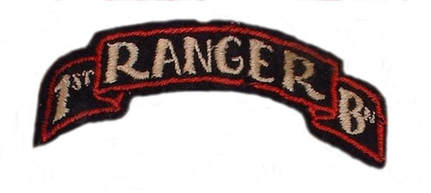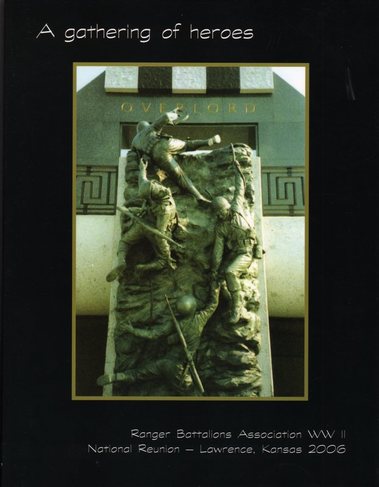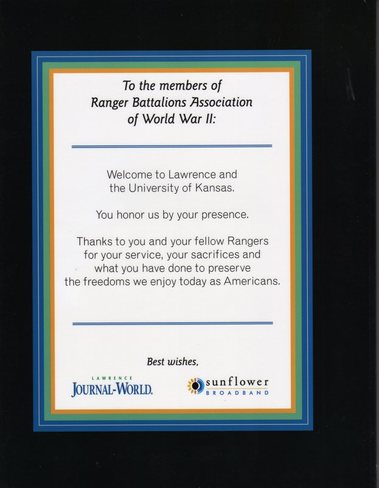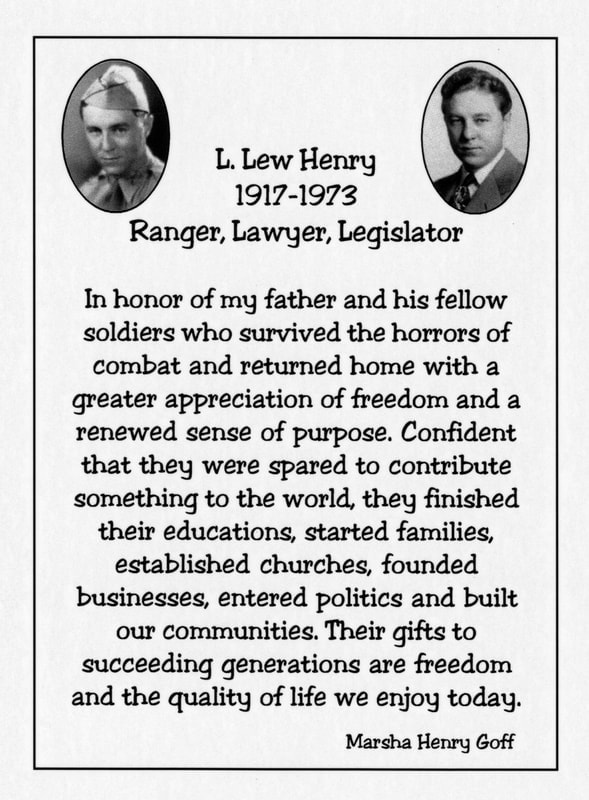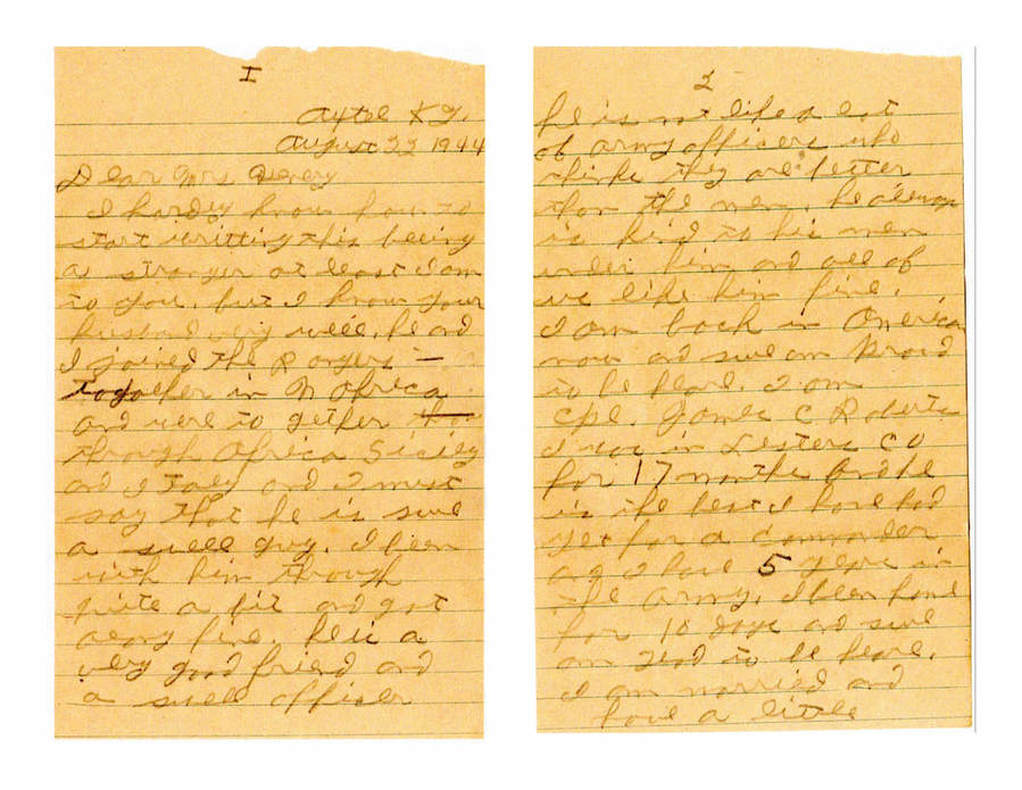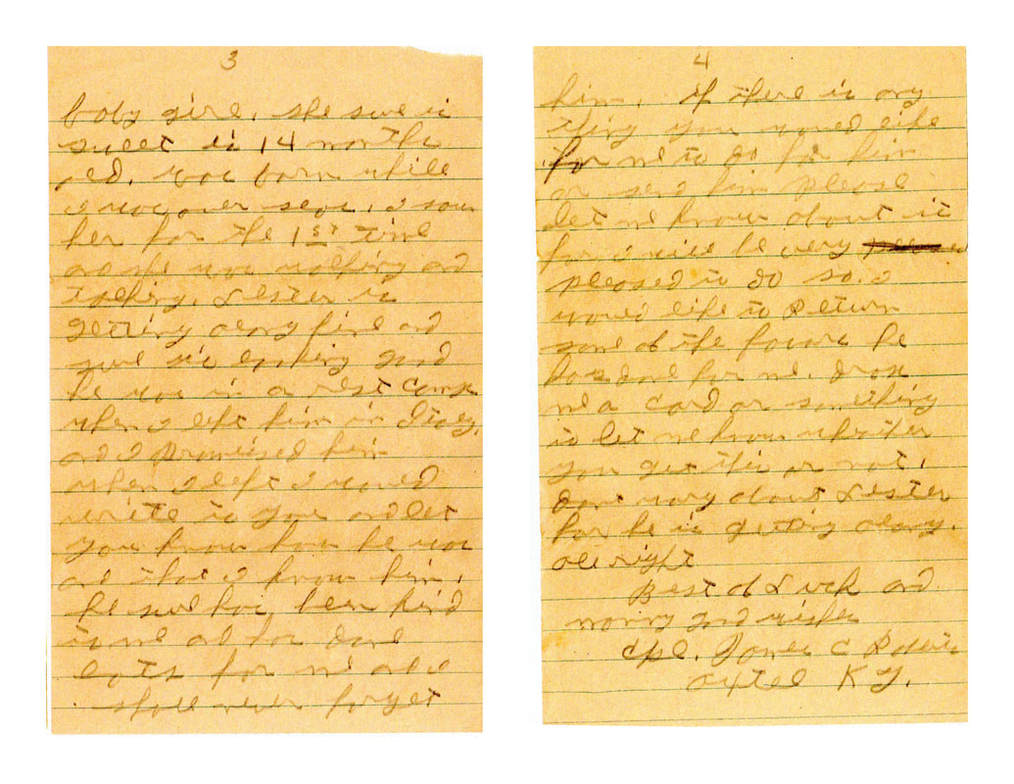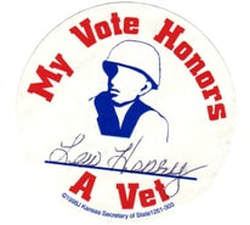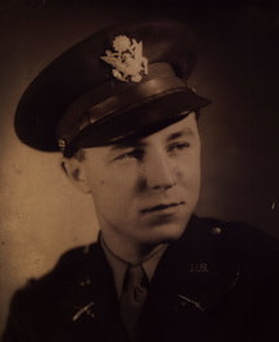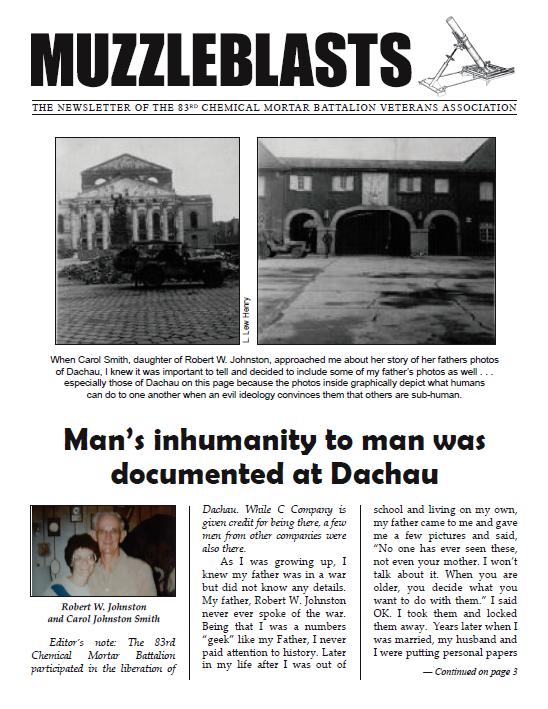The 2006 WW II Ranger Battalions Reunion in Lawrence
|
I went on a treasure hunt today and in a dark cabinet among other old CDs, I found the 2006 reunion book in PDF. I'm such a control freak that I not only wrote parts of the book and edited all of it, I also created most of the ads and did the layout. Of course, that means that any mistakes you find are mine. The book contains stories told by the Rangers, most of whom are now no longer living. Not all the stories are of their combat experiences, but many are. The Rangers were the spearheaders, the first on the beaches of the allied forces that invaded Africa, Sicily, Italy and France and fought their way through Europe. The 1st Ranger Battalion was in combat from the fall of 1942 and added the 3rd and 4th Battalions in the spring of 1943. All three battalions did hard fighting in Africa, Sicily and Italy, participating in D-Day Sicily. D-Day Salerno and D-Day Anzio. They were disbanded after Cisterna when the three Ranger battalions were decimated by an overwhelming Nazi force equipped with tanks and self-propelled guns. The 2nd and 5th Rangers invaded France on D-Day Normandy in June 1944 and fought in the Battle of the Bulge and throughout Europe. The 6th Rangers fought in the Pacific and participated in the raid on Cabanatuan which was portrayed in the movie, "The Great Raid." If you would like to read the book, click here. The following article was published in my Jest for Grins column on Father's Day, 2007. I frequently wrote about Dad on Father's Day. MHG The father I didn't know
We know our fathers for all of our lives ... but not for all of theirs. While Grams told me what Dad was like as a boy — mischievous, adventuresome and a risk-taker — and Mom described him as a young man — caring, fun-loving and an avid sportsman — neither knew much about his service as an Army Ranger officer in World War II. They didn’t know because, like many combat veterans, Dad didn’t tell. Perhaps he wanted to forget or simply realized that those who hadn’t experienced combat couldn’t understand.
I am blessed that Mom kept Dad’s wartime letters. In a letter to his parents from Anzio Beachhead in April 1944, he depicted the role of a combat soldier: “War cannot be described; only those who have experienced combat can have any conception of the term .... To the combat soldier who lives in holes like animals, whose existence is characterized only by the barest minimum of the necessities of life, and who has for almost a year and a half suffered day after day from heat or cold, in desert or in icy, muddy mountains, going without sleep, or bathing, or changing clothes for days, weeks and months, life has been crystalized into the expression of one desire — to return home!” In October 1943, Dad wrote Mom that he met two of his KU Delta Upsilon fraternity brothers, both serving with the 1st Division, in Oran where they had a big party before the invasion of Sicily. Sadly, the letter contained a postscript about his friends, who died in Sicily and whose names are inscribed on the tablets in KU’s World War II Memorial Campanile: “They thought I was in a suicide organization. Now they are dead and I am still alive.” My quest to learn about Dad’s military experiences began because my mother, his widow for three decades, wanted to know about those missing years. When she died in 2004, my mission changed. I now seek information for my sisters, for my children and theirs. And to learn about the father I didn’t know. Ray and I recently attended a mini-reunion of WW II Rangers at a beautiful resort on Iowa’s Lake Okoboji. There I met 84-year-old Sgt. Les Cook — winner of Silver Stars in World War II and Korea and wearer of a Green Beret in Viet Nam — who rides his bicycle 40 miles daily. Cook, with 1,004 parachute jumps to his credit, is an original Ranger who was trained in Scotland by British Commandos. He admits he was unimpressed when his captain called him in and introduced my father, who had joined the Rangers in Africa, as his new lieutenant. The Rangers were fairly strict in accepting only single men, so the jury is still out on whether Dad concealed that he had a wife and three children. Personally, I think that Dad’s fluency in German and knowledge of Italian and French may have made him a valuable acquisition in spite of his family baggage. Les Cook was surprised by something about Dad that didn’t surprise me at all. He said the captain told Dad to listen to his sergeant who had participated in the invasion of Africa and was battle-hardened. “When you think you’re able to take over the platoon, tell Sgt. Cook and he will give it to you.” “That’s exactly what happened,” says Cook, “It worked out O.K.” But he is still surprised that Dad, who at 26 was an old man for a Ranger, listened to and learned from his 19-year-old subordinate. I told Sgt. Cook that I grew up with this advice from Dad: “There isn’t anyone, Marsha, who doesn’t know something that you don’t ... and if you close your mind to that, you will never learn what they have to teach you.” Dad obviously was following that advice long before he gave it to me. Loving and considerate, Dad went shopping and bought a white organdy dress with a pink sash for me to wear at my 6th grade graduation ceremony. And he had my white satin ballerina slippers dyed red to match the ruffled tulle formal Mom made for my 9th grade dance. Compassionate and brave, he jumped into a lake to rescue a dog, apparently the world’s only non-swimming cocker spaniel, that I had adopted and named RayGee after the boy who would later become my husband. A risk-taker to the end, Dad went to Abilene shortly before his death and talked someone into letting him ride a Brahma bull because it was something he “always wanted to do.” Perhaps the father I didn’t know was the father I knew all along. Happy Father’s Day to all fathers ... and especially to Ray who changed his sons’ diapers long before it became cool for fathers to do that! |
Honoring those who returned from WW II
|
|
It goes without saying that we honor those who died under foreign skies in World War II, but in the above ad for a Ranger reunion book, which I recently found in a rarely-opened folder on my computer, I honor my father and those who did return, the majority of whom held the nightmares they had witnessed at bay and returned to the lives they left.
I also found a letter written to my mother in 1944 by a Ranger who served with Dad. That letter from James C. Roberts, along with another letter sent to Dad after the war by an 83rd Chemical Mortar Battalion (the unit Dad joined after Darby's Rangers were disbanded and with which he served until the war ended) soldier named Elwood "Long John" Guthrie, means more to me than Dad's medals. Roberts' four-page letter, written in pencil on tablet paper, follows (you may click on the pages to make them larger): |
I honor veterans with my vote
Comparing WWII and Vietnam War Warriors: Heroes All

In the Spring of 2023, I had occasion to write a magazine article about Bob Dole's WW II service. At the same time, I wrote an article about Vietnam veteran John Musgrave for another magazine. Both men were grievously wounded in their respective wars so I compared their experiences in an issue of Muzzleblasts. If you would like to read that issue, click here.
Exactly a year later, I had the opportunity to compare the WW II and Vietnam experiences of two more warriors, a father and son, Ford and Ken Hopkins. If you would like to read that issue of Muzzleblasts, click here.
|
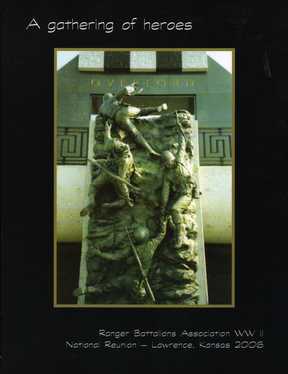
I produced this book for the WW II Rangers when they held their national reunion in Lawrence in 2006. It is no longer available, but I think you might like to see the book's cover, a photo of the sculpture "Scaling the Wall" which depicts Rangers climbing the cliffs at Pointe du Hoc. The late sculptor Jim Brothers created magnificent sculptures at the 50-acre monument to honor those brave Americans who fought and died at Normandy on June 6, 1944 and subsequent days.
|
Micki Carroll gave a talk at the Eisenhower Museum in Abilene
about her book, A Wyoming Cowboy in Hitler's Germany.
If you would like to watch it, please click here.
Homecoming: Seventy Years after their largely
unheralded return, area World
War II veterans look back on their service and
their reentry into civilian life.
|
Here's a link to my recent article in Topeka Magazine about five heroic WW II veterans. Bill Stephens, the Topeka photographer with whom I worked did a superlative job on the photos. http://issuu.com/sunflower_publishing/docs/tm14w/48
|
Happy Father's Day to Veterans!
Click HERE to read a column entitled Dad, I hardly knew ye,
that I wrote about my soldier father.
Click HERE to read a column entitled Dad, I hardly knew ye,
that I wrote about my soldier father.
|
My interest in WW II history is due to my late father, L. Lew Henry, who was a Darby’s Ranger in WW II, serving as a lieutenant in both F Company of the 1st Ranger Battalion and A Company of the 4th Ranger Battalion. He began the war in Africa, fighting through Sicily and Italy, and was wounded during the Anzio invasion, causing him to miss the disaster at Cisterna. After recovering, he fought on Anzio Beachhead with the First Special Service Force under the command of General Frederick. After Darby’s Rangers were disbanded, he joined the 83rd Chemical Mortar Battalion (aka "The Rangers’ Artillery"), fighting with them through France, Alsace, and Germany until the Nazi surrender.
The invasion of Sicily was a bloody battle . . . so costly in human life that one Ranger participant said if that (or any) WW II invasion could have been shown on television, the American people would have said, "Bring them home!" The Cisterna debacle in which Rangers of the 1st and 3rd Battalions were surrounded by an overwhelming German force and, with the exception of only eight men, were all killed or captured. Several former POWs from the Cisterna battle contributed to this article. Click HERE for the article about 1st, 3rd and 4th Battalion Rangers. The Raid on Cabanatuan was depicted in the movie The Great Raid. If you haven’t seen it, I highly recommend that you do. A force of 120 6th Battalion Rangers (the only Ranger Battalion in the Pacific Theater) and a dozen Alamo Scouts, assisted by 200 Filipino guerrillas and the help of Filipino civilians, successfully rescued 512 survivors of the Bataan Death March who were incarcerated by the Japanese at Cabanatuan. I had the good fortune to meet the late Captain Robert Prince, considered the raid’s architect, during the Rangers’ national reunion in Lawrence, Kansas in 2006. He contributed greatly to the following article Click HERE for the article about the rescue of POWs held at Cabanatuan. D-Day appears to be the only WW II action that many reporters of the present day are aware. That fact is readily apparent in the way they bypass interviewing brave veterans of the 1st, 3rd, 4th and 6th Ranger Battalions in favor of those equally brave 2nd and 5th Rangers who participated in the D-Day invasion. That said, D-Day was an amazing wartime feat by the allies. The assault on the Normandy cliffs was both daring and deadly and depicted by sculptor Jim Brothers in larger-than-life-size-scale at the site of the D-Day monument in Bedford, Virginia. The stories by participants and photos in the following article make it worth reading. Click HERE for the D-Day article. Every Memorial Day, my friend Franck, his wife and two children of Normandy, France , honor two Rangers killed on D-Day by placing flowers on their graves in Colleville sur Mer cemetery. Franck says that his “greatest ambition is to be able to pass on to our future generations the story of the veteran Rangers and other men to whom we as French people owe our freedom. We have decided to take care of two Rangers’ graves because we do not want to forget, and it is our way to say thank you to all of them.” Click HERE to read about Franck and the Rangers whose graves his family decorates. |
Heroes of The Greatest Generation
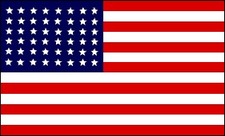
L. Lew Henry, my father, was in the 1st and 4th Ranger Battalions and in Companies D and A of the 83rd Chemical Mortar Battalion. To read a short booklet, The Lost Ranger, which I wrote about him, click HERE.
Bill Munoz was in the 5th Ranger Battalion in World War II. To read his story, click HERE. Stitt Robinson participated in two glider invasions in World War II. To read his story, click HERE. Crosby "Bing" Powell was in the 34 Infantry. To read his story about the battle at Monte Casino which I wrote for Topeka Magazine, click HERE. |

